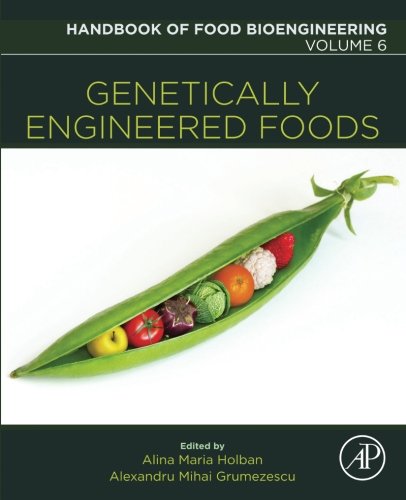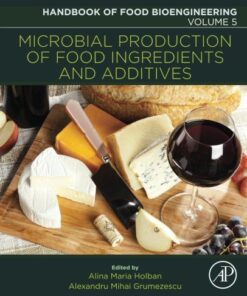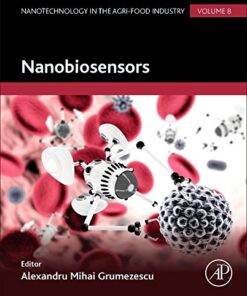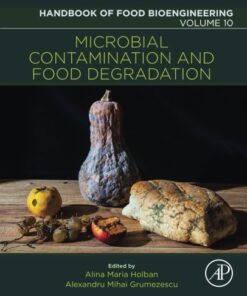(PDF) Genetically Engineered Foods By Alina Maria Holban
$22.00
Download instantly Genetically Engineered Foods By Alina Maria Holban, Alexandru Mihai Grumezescu. It is ebook in PDF format.
ISBN-10: 0128112700 ISBN-13: 9780128112700
Preview
This is the PDF eBook version for Genetically Engineered Foods By Alina Maria Holban, Alexandru Mihai Grumezescu
Table of Contents
Foreword
Series Preface
Preface for Volume 6: Genetically Engineered Foods
Chapter 1: Genetic Engineered Organisms (Plants and Animals)
Abstract
1. Genetic Engineering
2. Purpose of Genetically Engineered Organisms
3. Genetic Engineering Versus Hybridization Techniques
4. Genetically Modified Plants
5. Techniques to Develop Genetically Modified Plants
6. Genetically Modified Animals
7. Molecular Advancements in the Development of GM Animals
8. Significance of GM Livestock and Fishery
9. Other Unrevealed and Impulsive Effects of GMOs
10. Risk Assessment
11. Biosafety Regulations in Pakistan
12. Cartagena Protocol on Biosafety
13. Conclusions
14. Future Prospects
Chapter 2: Sugar and Sugar Alcohol Production in Genetically Modified Cyanobacteria
Abstract
1. Introduction
2. Cyanobacteria
3. Production of Sugars and Sugar Alcohols
4. Human Health Concerns About Cyanobacteria
5. Conclusions
Chapter 3: Genetically Modified Plants as Sustainable and Economic Sources for RUTFs
Abstract
1. Introduction
2. Ready-To-Use Therapeutic Foods
3. Perspectives for Alternative Sources
4. Crop Plants
5. Herbs and Noncrop Plants
6. Cultivated and Wild Edible Mushrooms
7. Genetic Modifications to Enhance the Nutritional Quality of Plants
8. Micronutrients
9. Antinutritional and Promoter Factors
10. Essential Amino Acids
11. Ethical Issues
12. In Silico Tools for RUTF Development
13. Food Processing Techniques
14. Conclusions and Future Perspectives
Chapter 4: Approved Genetically Engineered Foods: Types, Properties, and Economic Concerns
Abstract
1. Introduction
2. Advantages of Genetically Modified Foods
3. Common Genetically Modified Foods
4. Risks Associated With Genetically Modified Foods
5. Economic Concerns
6. Conclusions and Perspectives
Chapter 5: Influence of Feed From Genetically Modified Plants on the Composition and Quality of Foods of Animal Origin
Abstract
1. Introduction
2. Global Food Situation
3. Feeding Studies With GM Plants of the 1st Generation
4. Feeding Studies With GM Plants of the 2nd Generation
5. Conclusions
Chapter 6: Genetically Modified Microorganisms: Harmful or Helpful?
Abstract
1. Introduction
2. Incidence of Microorganisms in Foods
3. Strategies for the Improvement of Microorganisms in Foods and Beverages
4. Conclusions
Chapter 7: Techniques for Production and Quality Assessment of Genetically Modified Foods
Abstract
1. Introduction
2. Types of GM Foods
3. Production of GM Foods
4. Risks Related to Genetically Modified Foods
5. Methods for Assessing the Safety Profiles
6. Testing and Labeling of Genetically Modified Foods
7. Conclusions
Chapter 8: Awareness and Utilization of Genetically Modified Foods in Nigeria
Abstract
1. Introduction
2. Nigeria as a Country
3. Agriculture in Nigeria
4. Animal Rearing in Nigeria
5. Problems and Proffered Solutions of Agriculture in Nigeria
6. Awareness and Utilization of Genetically Modified Foods in Nigeria
7. Some Genetically Modified Foods in Nigeria
8. Advantages of Genetically Modified Foods
9. Challenges Related to Genetically Modified Foods
10. Controversies About Genetically Modified Foods in Nigeria
11. Conclusions
Chapter 9: Biosensors as Advanced Device for the Transgenic Plants and Food and Detection
Abstract
1. Introduction
2. Conventional Analytical Methods for the Assessment of GMOs
3. Biosensor Development for the Assessment of GMOs
4. Conclusions
Acknowledgments
Chapter 10: Genetically Engineered Food Crops to Abiotic Stress Tolerance
Abstract
1. Introduction
2. Genetic Transformation of Plants
3. Proteins With Protective Roles Against Abiotic Stress
4. Signaling MoleculesTranscription Factors
5. Osmoprotectant Metabolites
6. Conclusions
Acknowledgments
Chapter 11: Detection of Prevented DNA Damage by Therapeutic Foods
Abstract
1. Introduction
2. DNA Damage and Aging
3. Therapeutic Foods (Nutraceuticals)
4. Detection of Prevented DNA Damage
5. Conclusions
Chapter 12: Genetically Engineered Crops: Opportunities, Constraints, and Food Security at a Glance of Human Health, Environmental Impact, and Food Quality
Abstract
1. Introduction
2. Green Revolution
3. GM Crops: An Overview of Human Health, Their Environmental Impact, and Food Quality
4. Fulfill Food Needs by Increasing Food Production
5. Safety Issues
6. Gene Flow and Landrace Contamination
7. Swapping Insect Pests for Targeted Attacks
8. BT Crop Resistance
9. Superweeds
10. Bioethical and Social Issues of GM Crops
11. If Anything is Wrong With GM Technology There is no Turning Back!
12. Food Security
13. Conventional Breeding, Biopesticides, and GM Crops: What to Choose for Food Security?
14. Conclusions
Acknowledgments
Chapter 13: Safety and Risk Assessment of Food From Genetically Engineered Crops and Animals: The Challenges
Abstract
1. Introduction
2. Safety and Risk Assessment of Food From GE Plants (Crops)
3. Approaches to Safety and Risk Assessment
4. Problem Formulation
5. Procedures for the Initial Risk and Safety Assessment of GE Plants Described by Codex Alimentarius
6. The Novel Protein(s)
7. Animal Studies
8. Unintended Effects
9. New Molecular Modification Techniques
10. GE Stacked Events
11. GE Animals
12. The Precautionary Approach (Principle)
13. Societal Decision Making
14. Benefit Assessment
15. Conclusions
Chapter 14: Identification of Genetically Modified Foods
Abstract
1. Introduction
2. Sampling
3. GMO Testing Methods
4. Validation and Standardization of Analytical Methods
5. Conclusions and Perspectives
Chapter 15: Methods for Plant Genetic Modification
Abstract
1. Introduction
2. Methods for Genetic Modification
3. The Role of Epigenetics in Plant Transformation
4. Potential Risks Related to the Use of Genetically Modified Foods
5. Conclusions
Index




